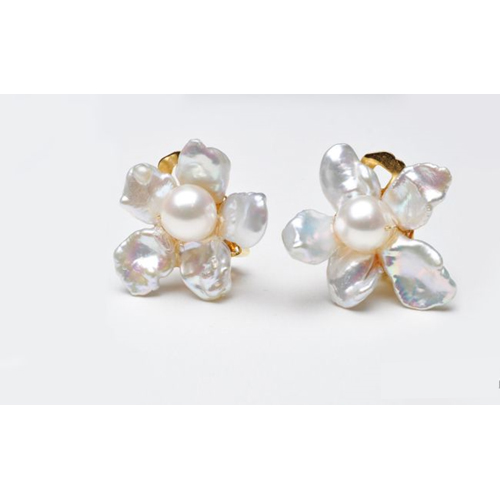Have you ever received a pearl gift or given someone a pearl?
The charm of pearls exists in every corner of the world. Since the beginning of historical records, pearls embody virtue, love, wisdom, justice, spirituality, and justice. Pearls have always been regarded as rare and priceless treasures and are considered symbols of all gems. Great poets of every age have written hymns to pearls. There is no exception to expressing the praise from ancient China, India, Persia, Egypt, Greece, Rome, the Mayan, Aztec, and Inca cultures of the Americas, and even the ancient civilizations of the South Pacific and Australia pearls.

Pearls symbolize wealth
Pearl is the birthstone of June. Compared with other gemstones, its history is more ancient, mysterious, spiritual, and favored by imperial families. The portrait collections in the world's major museums reflect the unparalleled prestige of pearls and the awe of pearls at that time. We will find ourselves adorned with pearls in many famous era portraits. None of their wealth was more attractive to them, and none more suitable to accentuate their wealth than pearls.
Pearls symbolize praise
The world's great literary works have praised the value and reputation of pearls. The ancient holy books of the Hindus, the Bible, the Talmud, the Koran, Dante's poems, and Shakespeare's plays have this compliment. The great Roman historian Pliny also praised it in his works, and from Pliny's works, we learn about the world of gems and the various beliefs people had about them at the time.
Pearls are beauty after hardships.
In the modern world, people more or less know where pearls come from, and then the exquisite pearls bring people a series of awe, doubts, and even more feelings of love and hate. For many people, pearls use as a metaphor for the beauty and poetry of life. In this world, people may often think of the difficulties faced in life. Overemphasizing the problems may obliterate our will to live, but the delicacy of pearls constantly reminds people that some things that seem unfortunate at first sometimes lead to good results. If there is no previous bad, there will be no later good results.
As you can see, a pearl would not have grown on its own in a pearl mussel shell without the tribulation and struggle. Perhaps more importantly, the presence or absence of pearls or the quality and color of pearls depends mainly on how a single mollusk survives in the environment. Not all mollusks live in the same environmental conditions. Pearls can produce everywhere. Even if they can make, they are not necessarily all the same beautiful, which is the same as our real life.
Pearls symbolize beauty
We have no way of knowing exactly when and where discovered pearls, and maybe it has been before historical records emerged. Presumably, people were searching for food in ancient times when one of the anglers found the pearl. But in any case, the unique beauty and origins of pearls make them worthwhile once they introduce.
Pearls symbolize nobility
Unlike diamonds and colored gemstones, pearls are already beautiful when you first notice them. They don't need to be optimized, cut, and polished. A good pearl has its depth and luster as if it radiates brilliant colors from the inside out. We can imagine how amazing it was when people in ancient tribes ate or opened shellfish and found a sparkling round pearl hidden inside. At that time, people put everything related to nature. worshippe Power as a god, so the amulets they wear are more precious than anything else. When they hold the natural treasures from the living body, they are amazed and in awe, but also, in their minds, the pearl with a soft luster is simply a living being.
Pearls are considered the king of beautiful, standard, and precious gemstones. In ancient times, people believed that inanimate objects possessed special powers that could transmit to their owners or those who wore them. Pearls come from marine organisms, and their inherent luster contains a unique vitality that is more powerful and valuable than any other wealth.
Pearls are symbols of gods.
We may never know precisely when and where to find pearls, but we know that people have been in awe of their existence since historical records. In China, Trace the history of pearls back thousands of years.
From here, we found that a long time ago, pearls were associated with a person's good deeds, and people hoped to inspire and guide everyone to live a life of good deeds. These records may be the first time that the connection between pearls and recorded good deeds in the annals. In China, pearls are one of the Seven Treasures of Buddhism. Small mother-of-pearl-covered Buddha statues and other buildings were very popular more than a thousand years ago. People cleverly inserted thin lead sheets into the bodies of freshwater mollusks to obtain an outer layer of pearls. And then cover them with Buddhist utensils.
Pearls symbolize friendship
Rulers love pearls in ancient India and Ceylon. In antique boxes dating back 2,500 years ago, we found records of pearl fishing in the coastal areas near Ceylon, and the price of pearls was also prohibitive. Ceylon even regards pearls as a vital token of friendship for messengers to India and presents them to other countries.
Pearls symbolize beauty
When small-scale pearl mining appeared in Ceylon, the pearl industry flourished throughout the Roman period. When referring to Ceylon, the Roman historian Pliny specifically pointed out that Ceylon was the main output of pearls. The excellence of the land. Persian Gulf has produced pearls in the Persian Gulf since 10 BC, and most of the beautiful pearls come from the Bahrain Islands. From that time until the middle of the 20th century, the Persian Gulf was the leading source of most of the world's heavyweight pearls. Portraits of Persian kings and queens feature pearls as ornaments, and a necklace with pearls and other precious stones in the French Louvre collection dates back to the 4th century BC.
When it comes to the ancient Greek god of love, Aphrodite (called Venus in Rome), people often think of pearls and associate this closely. It is possible that during the conquest of Egypt and Greece by ancient Persia, they introduce pearls to these places, and through Greece and Egypt, to Rome and the rest of the world. We found that during the reign of the Roman Empire, pearls were also closely associated with the Roman god of love, Venus. The connection between pearls and love is also an excellent testament to the cherishing of pearls by the ancients. Another contribution of these early expeditions was the development of pearling in the Arabian and northern African regions of the Red Sea coast, which were no longer in existence and were essential sources of pearls.

Margarita - a natural pearl
Pearls symbolize good luck.
The Romans loved pearls, the women generously displayed what they had, and their love for pearls knew no bounds. No one in Rome was more enthusiastic about pearls than the general Pompey, who showed personal portraits made of pearls in his marching procession. For the Romans, pearls were their most worthy pursuit from the great powers of the East. Wealthy Roman women would inlay their beds with pearls to ensure a good night's sleep. In the late Roman Empire, the country implemented the thrift decree, trying to limit the display of pearls by the public, and the number of pearls worn by an individual at a time could not exceed the regulation. According to Pliny, in the 1st century AD, pearls were the first of all treasures.
Pearls symbolize purity and preciousness.
The Romans used two words to describe "pearl" (pearl). If it is a large and beautiful pearl, "unio" means unique. The Romans also used the word "margarita" (Greek for "pearl") to imply a priceless treasure worth cherishing. "Margaret" (Margaret) and the deformed "Marguerite" and "Margarita" all mean "pearl," which integrated with the purity, spirituality, virtue, and nobility of pearls since Roman times.
Pearl, Perle, Paarl, Perla…
The word pearl is similar in many languages, being "pearl" in English, "Perle" in French and German, "Paarl" in Dutch and Swedish, and "Perla" in Italian and Spanish. Because many pearls were known to the Romans, it believes today that the word pearl comes from the Roman word "Pirula," which means "teardrop-shaped." The term "Pirula" spread throughout Europe with the expansion of the Roman Empire. It has been used to describe the shape of many natural freshwater pearls and later gradually replaced the word "unio" to describe the natural beauty of pearls.
Contact: Lee
Phone: 008615812571762
E-mail: le@lerings.com
Whatsapp:008615812571762
Add: 3F,#4 ShangXing Road, XingAn ChangAn Town, DongGuan,China
We chat